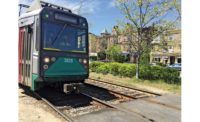Fast-Track Design Begins for Complicated Boston Bridge Replacement

Photo Courtesy of MassDOT

Photo Courtesy of MassDOT


A fast-track design replacing an old drawbridge over Boston’s Charles River is now underway, meant to address severe skews while minimizing disruptions to 50,000 weekday commuters.
Massachusetts Bay Transportation Authority (MBTA) officials say replacing the North Station Drawbridge will require extensive planning and coordination. Construction staging of the movable bridges and approach trestles while maintaining access to the 10-track, 5-platform North Station, immediately south of the bridges, is considered “the biggest challenge,” says Kenneth Cadman, MBTA senior director of bridge and tunnel projects.
Following a four-month bidding phase, the agency in November initiated the $100 million design-build project now in phase one pre-design with overall design expected to take 32 months and construction completion by 2026. Due to the aggressive schedule, phase two preliminary design (0-30%) is scheduled to start by mid-December, Cadman says.
STV will manage structural, mechanical and electrical bridge design and civil/site work with HNTB managing rail design and TRC working on environmental approvals and permitting.
“The team will work together closely to coordinate both the bridge design and construction staging with the track design” while maintaining access to North Station platforms and keeping passenger trains moving without delays, Cadman says.
The agency is considering building three smaller bridges in stages, each holding two tracks, an MBTA spokesperson says. To avoid disruption to current schedules, the first bridge would be built alongside the existing spans before the older bridges would be removed one at a time to keep four tracks in service.
The current phase includes project management work, an existing bridge structure evaluation, a track evaluation, a utility investigation, and a bridge railroad operations report, Cadman says.
Among the multiple complexities of this project, Cadman says adding a proposed bridge outboard of two existing bridges that cross the Charles River “will complicate the demolition and construction of the middle bridge while maintaining train movements over the Charles River to North Station.”
In addition, he says the movable bridges “require close coordination between the structural, machinery, and electrical engineers to fit all of the required equipment in the confined access between the in-service tracks.”
The nearly 90-year-old North Station Drawbridge—a twin pair of skewed single leaf Scherzer Rolling Lift Spans with a bridge toe on a severe 56-degree skew—has structural deterioration and frequent operational problems that affect service, according to the MBTA.
The superstructure system consists of two 118 ft-long x 24-ft-wide steel spans, including a through truss bascule span and a track-girder span with navigation horizontal clearance of 65 ft and vertical clearance of 5 ft.
Jody Ray, MBTA assistant general manager, says the twin drawbridge is “a chokepoint” as the single busiest bridge on Boston’s north side “and probably the entire commuter rail system” since it takes every train that passes through North Station.
On weekdays, the narrow drawbridge is a bottleneck for the 200 Amtrak and MBTA trains it carries out of North Station’s railyard. This leaves the agency without ample room to use two of 12 rail lines behind North Station.
Building a wider bridge with six rail lines, instead of the current four, will accommodate a greater number of platforms for passenger service.
Deterioration of the supports for the flat tracks and segmental girders “have likely caused the curved tracks to move out of alignment as the load positions change during the opening and closing of the bridge” Cadman says. Currently, the movable span opens to about 30 to 35 degrees, but was originally designed to open to about 85 degrees.
“Due to the poor condition of the tracks “the bascule has difficulty reaching the fully seated position, especially in hot weather,” he adds.
Valerie Fletcher, executive director for the Institute for Human Centered Design, a 41-year-old nonprofit that plays a role in design and social equity with an emphasis on disability and aging, says the institute will develop and execute a plan to disseminate information to disabled and elder stakeholders with STV. “IHCD is the content developer for the new MBTA Design Guide for Access and we will bring that guidance to the project,” she says. “It encapsulates new policies from MBTA relative to accessibility.”







